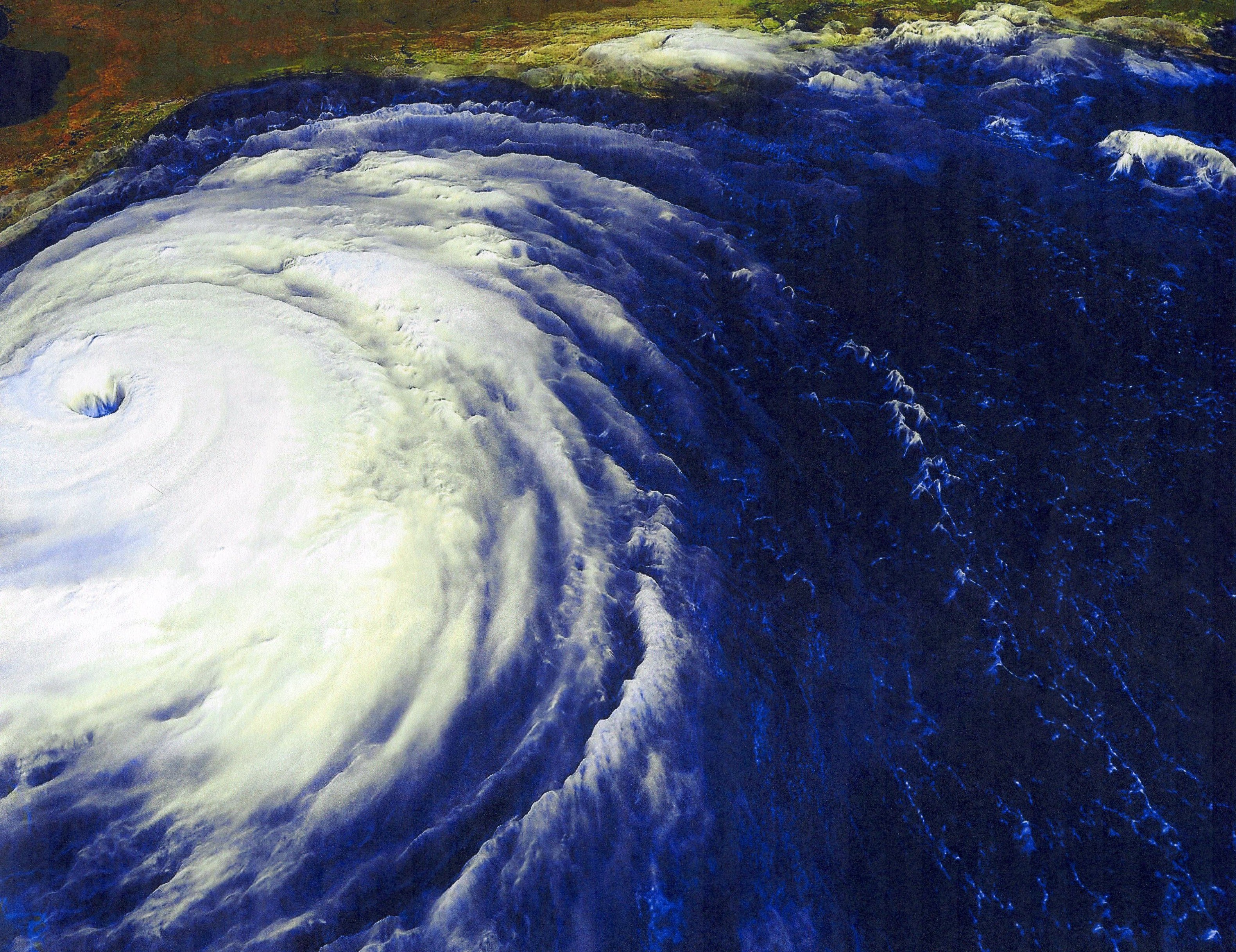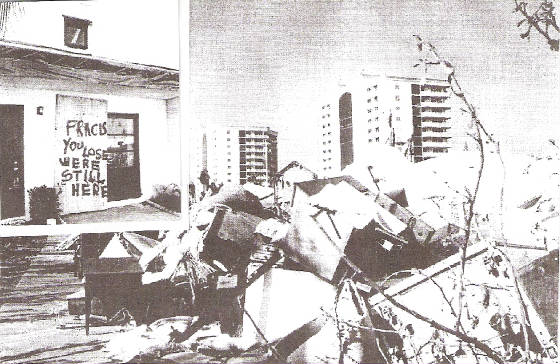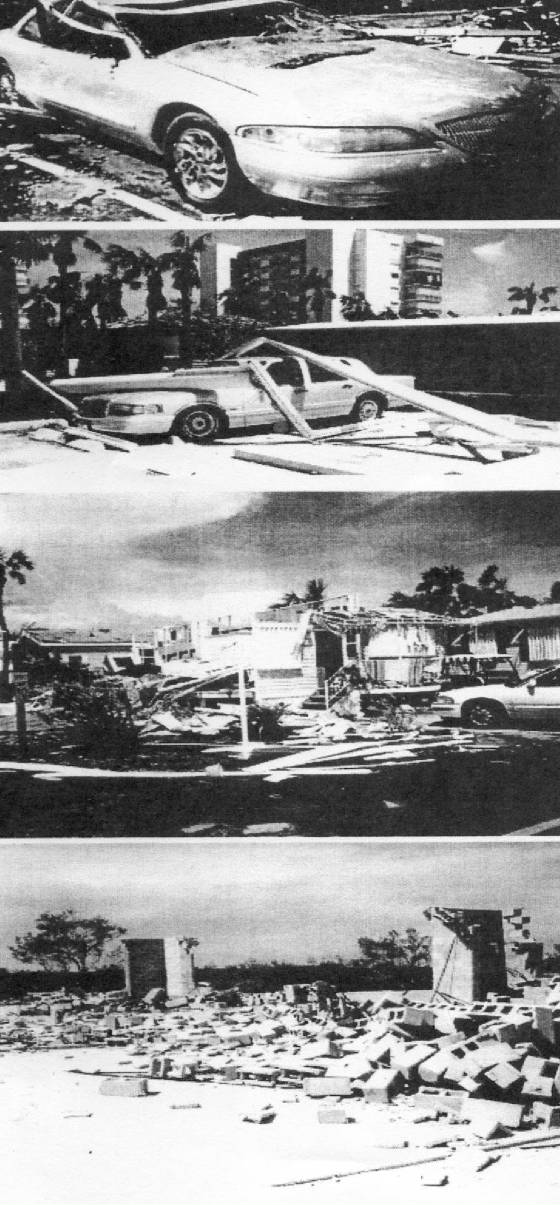|
|
|
Twin 'canes of 2004

In 2004 the treasure coast was hit with 2 major (Category 2) hurricanes just 2 weeks apart. These were named Frances and Jeanne. Both made direct hits on North Hutchinson Island, a situation not faced in its modern history. Total evacuation was ordered for both hurricanes and firefighting and rescue resources were removed until the hurricanes had safely passed. Electrical power was cut off before the storms hit and with it went the water source because of no pumping capability. Sewage is basically gravity powered except for lift stations where large pumps elevate the accumulation to a level that gravity carries it to the next lift station, so sewage disposal was also severed. The county sheriff blocked the island from all entry for both safety and looting prevention purposes. A curfew was also imposed after several days when the sheriff permitted limited entry for some residents and support personnel. Devastation was rampant. There was debris from partial building and vegetation destruction everywhere. A majority of the power poles were either down or badly damaged. Many side streets and parts of A1A were impassable. Five single houses along A1A in Ocean Resorts had burned to the ground. This was the visible damage, but what was even worse for many was the water damage inside buildings, much of it hidden, and the longer term mold and mildew problems that it created. Fortunately the main force of the hurricanes hit at low tide or damage could have been worse. As it was, there were several spots where the ocean penetrated far enough to give a few trickles across A1A with no real damage. The coastline, however, was rearranged! At some places 4-10 foot depths of sand were moved elsewhere and docks and boardwalks either disappeared or were in shambles. Water level of the Indian River rose about 5 feet for Frances and 6 feet for Jeanne above its normal high water level. This was above the level of many docks on the river and created floatation destruction to further compound the boat mooring issues created by the 100 to 120 MPH winds. Numerous damaged or destroyed boats were scattered around the waterway. The remains of some destroyed boats still existed in 2012, although new plans were being formulated for their removal.
FEMA, the Red Cross and electrical repair crews from many states were streaming into the treasure coast as fast as they could. As residents and workers were able to get onto North Beach, the piles of debris along A1A started to grow. The county manager had announced that all debris placed along A1A would be picked up free of charge, but that there would be no pickup service in gated communities. Much debris from the first hurricane had not been removed when the second one hit 2 weeks later and that debris was not only rearranged but caused more damage in the process. Letters to Congressmen regarding the discriminatory policy with gated communities contributed to gaining assurances that such policy would not prevail in the future should another hurricane be experienced. The piles of debris stretched for hundreds of feet in several locations, and were 10-15 feet in height. They contained almost anything imaginable, like trees, roofing materials, whole roofs, mattresses, stuffed couches, pool and porch screening, wallboard, carpeting, kitchen cabinets, fencing, etc. Cell phone service did work at times but the service was quite intermittent. A few land line phones somehow managed to stay operable during the hurricanes and the TV cable was allegedly working, although there was no power to operate TVs. After the first hurricane, Islanders were all told that FEMA was providing food and water for everybody, but isolated on the island they saw nothing. Finally Shirley Burlingham called the right official and found out that the Red Cross was carrying the island as "closed" because they tried to get on the first day and were turned back by the sheriff. Within a few hours of Shirley's call more food and water arrived on the island then could possibly be used. Lift stations became a problem without electricity. There was no running water, but people were flushing their toilets with bucket of water from stagnant swimming pools, ocean, or river. Large tank trucks with pumps had to be used to empty lift stations until power was restored. This was a costly operation and communities with their own lift stations were forced to bear the cost for their own lift stations (even if they had back up power) because the county lift stations were full and had no power.
After the hurricanes the county, on a surprisingly prompt basis, sent building inspectors into the area to perform safety inspections and to mark dwellings before people were supposed to enter them. They fastened signs to buildings that not only had text messages but also carried color code where RED was damaged beyond repair and dangerous -do not enter, ORANGE was not habitable, may be salvageable but only enter with extreme caution, and GREEN was habitable but may have damage. Total damage on the island ran into millions of dollars and it took years to recover. Special assessments at some condos ran well into 5 figures per unit.
The hurricanes destroyed two substantial beachside commercial properties. PV Martins had been very popular dinning places for many years. Although it closed its doors a year earlier, the hurricanes did sufficient damage to cause its demolition. The other destroyed beachside establishment was the Radisson Inn. This had become a totally refurbished Radisson in 1998. While much of the structure stayed standing, it was damaged beyond repair and was demolished. On September 12, 2005, teary eyed Northbeachers watched as a dozer started leveling what was left of the Radisson. By 2013 the former Radisson property remained vacant land waiting for purchase/development. The strip mall on A1A also received substantial damage and was condemned.
Many lessons were learned from those twin canes. These issues are much more critical for barrier island residents than for those on the mainland. Backup electrical power is essential for lift stations, essential communication centers and some critical offices. In fact some citizens now have generators for their private homes. Water and non-perishable food stocked up prior to a hurricane should be considered a necessity. Temporary lighting whether it be flashlights or lanterns, and a means of getting news, like a battery powered radio are very useful. A supply of extra batteries is essential. Most of the foregoing items may be needed for a substantial period even after returning from an evacuation because electricity may not be available for many more days. A pre-established evacuation plan is also very beneficial. Such plans need to consider medications, pets, means of transportation, fuel, etc. Fortunately in Florida, there is no need to provide for freezing weather, but means of staying cool may be a consideration, particularly if there are health issues. Most of the single house construction on the island since the hurricanes has been cement based systems (CBS) that can withstand hurricanes with minimal damage. Motor generator capability has been added to some facilities and housing units. Most of the damage to condominiums was caused by water intrusion and the weaknesses that permitted the intrusions have generally been corrected in the repair/recovery process.
While the twin canes were a shattering experience, there were no injuries of record on North Beach. For this all were thankful. Also, the arduous recovery effort seemed to cause people to pull together more than beforehand. That recovery went on for years and nobody escaped significant impact, for all buildings had damage. Ocean Resorts lost about 50 mobile homes that had less sturdy additions. In most cases the additions had sufficient damage to open the mobile home itself to decimation from within, although the mobile homes were still structurally intact. The island was crawling with insurance adjusters late in 2004 and early 2005. It is safe to say that the island fully recovered and is more beautiful than ever. However, the housing bust that started in full bloom in 2008 stopped further development in its tracks and businesses have not been re-established in most commercial properties as of 2013.


|
|